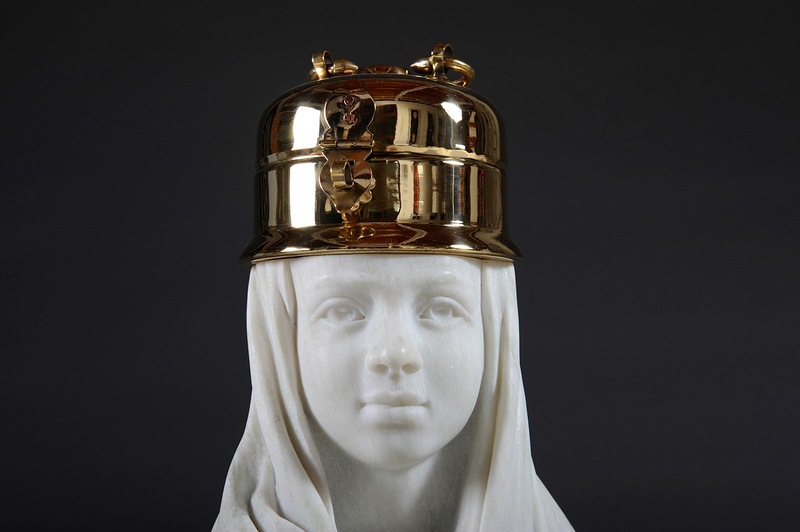Shows
Sivadol Sitipol’s “Back to the Moon”


Thai sculptor Sivadol Sitipol, who received silver and bronze medals in Thailand’s National Exhibition of Art in 1998 and 2002, respectively, stayed out of the limelight for 10 years. He has returned to mount a solo show, presenting works produced between 2010 and 2016 in India and Thailand. The exhibition explores Sivadol’s fascination with dualistic ideas of light and dark, good and evil, the potential of each and their relations to reincarnation. With mixed materials of wood, stone and steel, Sivadol focuses on balance and visual allusions to mysticism. Most of his sculptures fit neatly within this theme, while a few wander away; this is acknowledged by the artist himself— Sivadol says in his artist statement that these concepts “may not be related to sculpture,” but they “certainly concern the sculptor.”
Sivadol examines the transformation and marriage of materials in a trio of works. In The Horizontal Mountain (2012), he examines different stages of construction and destruction with a fallen tree pieced together by flat wood hexagons, the handles of a saw with teeth shaped like a skyline fixed within its trunk. This neat method of display raises questions about the saw’s ineffectiveness, fixed in the very material it is designed to destroy—a motif repeated throughout the series. The wood used to create the handles of the saw, the hexagon tiles of the sculpture and the silhouetted cities demonstrate the variety of ways in which the same material lives on, even after the original tree has died. Reincarnation, where one thing dies and then becomes another, is presented through the different manifestations of the wood—first as a natural object, then abstracted, and finally as part of a man-made product.

Humility of Sound (2016) relies on similar visual contradictions referencing ideas of morality and reincarnation; Sivadol created a pan balance with a marble tank gun as its center beam and Buddhist temple gongs as scales. The contrast between a devastating weapon and a religious object references human violence and religious morality, the gold and black gongs weighing these conflicting concepts of good and evil, connecting to karmic balance and reincarnation. Though it may appear a little on the nose, the piece is expertly crafted and perfectly balanced—during viewing, one side of Sivadol’s creation can be pulled so that it gently see-saws, demonstrating his attention to detail and embrace of movement. Attention is drawn to the moving parts and materials used in the piece and the rising and falling scales create uncertainty as there is no clear relationship between either side until the scales eventually return to equilibrium.
Sivadol’s choice of materials—a constant throughout his two-decade-long practice—is rooted in tradition but narrates human development. Saws, weapons and gas tanks reference expanding abilities in progressive life cycles. In his artist statement, Sivadol identifies the greatest evolutionary leap in the history of humanity as having taken place in recent centuries, an idea that connects to the goal of reincarnation as each new generation is part of a cycle of continual improvement and growth through technological developments and new scientific discoveries.

The piece that best demonstrates the marriage of materials and styles is Son of a Cow’s Sister (2015), a companion piece to an earlier work that depicts a marble portrait of a young girl. The top of her head is replaced with a bell-shaped brass container that opens to reveal an upturned mandala stamp, representing spiritual belief. Exquisite and interactive, the container can be closed to obscure the subject’s cerebral workings. The stamp, an object intended for reproduction, is distinctively shaped like an Indian mandala. As an artist who hails from one Buddhist country, producing works examining spirituality in another, the choice to delineate religion without using Thai imagery suggests Sivadol’s own evolution, and the impact of a different culture on his own religious practice. What the stamp is meant to print on is unknown, though its intended purpose of duplication indicates that the image can find new life on many new surfaces.


Sivadol’s examination of spiritual concepts through the use of traditional and organic materials, as well as the pieces’ connection to the human realm of thought and movement, is evident throughout the gallery, though there are areas where the exhibition lacks cohesion. While each sculpture stands on its own, some of the single-material pieces—such as Anatomy of a Line (2015) in which he examines the texture of a cassava trunk, or Necklace of Universe (2013) that references Indian aesthetics and plays with rough and smooth textures—lack a visual or thematic connection to the more dynamic sculptures in the exhibition. Instead of serving as part of a singular vision, many of the works exist in pairs or trios spread across the gallery, showcasing the many interests and of their creator. The most successful pieces in the exhibition are those that, rather than merely referencing contrasts, demonstrate this tension by incorporating divergent notions.
Sivadol Sitipol’s “Back to the Moon” is on view at YenakArt Villa, Bangkok, until January 15, 2017.







